PROLOGUE
Isn’t it strange to go to Chernobyl for the May holiday? – I ask myself, waiting to cross the Polish-Ukrainian border. 12 May days in the zone, and another 4 last month. The Ukrainian border guard who stops me might recognise me, but he definitely recognises my car. Despite the several pages full of red stamps in my passport, he asks again where I’m going.
– To Chernobyl – I answer, acting bored.
– What for? – to investigate.
– To relax, and breathe in a little iodine – I answer, testing the border guard’s sense of humour.
And actually, it’s the God’s honest truth that I’m going to relax. „Truth” because spring, the nature which hasn’t been touched by human hands for years coming alive, is truly delightful. Apart from the enormous mosquitoes. And „God’s” because it’s almost Orthodox Easter. The date is set in the same way as the time of Catholic Easter ‒ the first Sunday after the first full moon of spring. The difference in the date when it’s celebrated is because Orthodox Easter is set according to the Julian calendar, according to which it doesn’t happen until May 5.
THERE ARE NO NON-BELIEVERS IN THE ZONE
Despite the fact that I haven’t celebrated Catholic Easter in a long time, God, the same in both churches, probably wouldn’t have anything against me taking part in the Orthodox version. After all, there aren’t really many difference between the Catholic and Orthodox Church, it’s mainly in terms of doctrine. For me, the differences lie elsewhere ‒ an Orthodox service is an incredibly spiritual and emotional experience. Richly decorated gold iconostases (a wall with three doors which is covered in icons), amazing icons, the formal, richly decorated liturgical robes, the smell of incense and hundreds of burning candles and unusual singing. It’s enough to take you a step closer to heaven. Anyone who has been to a service in an Orthodox church even once will know what I’m talking about. Which is why I slip in to the church in Chernobyl right at midnight for the Easter service.

There I find a crowd of people, the majority of whom are resettlers, elderly people who came back to the zone without permission, and workers from the nearby nuclear plant. In the crowd I recognise a dosimeter operator and an old woman who I visited in Kupovate village last year. Everyone is singing. Across from the iconostasis and several icons there are candle holders with dozens of burning candles. When one goes out, it’s replaced by another, brought by a succession of people. I light mine. Every so often the „batiushka” (orthodox priest) emerges from behind the iconostasis, which separates the altar from the nave, carrying the trikirion and cross, and fills the iconostasis and the church with incense, while the worshippers sing out Christos voskresie! (Christ has risen). The next hours give way to liturgy, gospel, songs and hymns, full of praise and joy, in which the main theme is the Resurrection of Christ. The church only starts to clear out slowly in the morning. More people are leaving the church than coming into it. That’s probably the end of the service, I think to myself and I also go outside. So it comes as a surprise to me when I see hundreds of people standing one after the other around the church. With burning candles at their feet and dozens of baskets full of frosted sponge cakes (paska), bread, wine and eggs. Everyone is waiting to have the products they brought blessed.



It’s starting to get light when all of a sudden the sound of a bell loudly rings out. Then another, and another. I come closer to the place where the sound is coming from. From close up I notice not one, but a whole set of different sized bells. Below them stands a bell ringer in a dark robe who skilfully sets all the bells in motion, pulling up to seven ropes. Each of them plays their part, but all of them merge into one harmony in joyful celebration.

FORGOTTEN CHURCHES
The Chernobyl Orthodox church is the only one in the zone, or more precisely the only functioning one. The exclusion zone is too big, and was once too populous, for thousands of parishioners to fit into one church. Where are the rest? I asked an elderly resident of the zone for help and he gave me the names of abandoned villages where I should find churches. It’s no accident that he said „should”, because so much time has passed since the disaster, he didn’t know if they were still there. A map and GPS should be enough to check.
The first church, St. Nicholas, should be in the south of the zone in the village of Zamoshnaya. In the attempt to get there, I drag the car along completely abandoned and overgrown roads. The dense branches are constantly scratching the sides of the car and both mirrors have long since been broken by branches. It’s only when one of them hits me, leaving a bloody streak across my face, that I close the window. The last section takes the longest, the thick branches and scattered boughs of trees force me to stop the car and move them out of the way or find another road. Once I get to the site, it turns out that only the walls of the church remain.

But once I get closer I notice that one end of the building has a roof. And in some window frames I also see that new windows have been installed. White and plastic, they don’t match the rest. Intrigued, I walk into the building. At the end of it I see a wooden wall filling the role of a primitive iconostasis dividing the altar from the nave. There are three doors on the iconostasis. The middle one, the largest, is closed. This is the holy gate that only the batiushka can go through. On the right and left are the north and south gates. I manage to look inside through one of them.

I’m surprised by the Orthodox relics that are still there, icons, pictures and a cross and candle holder. Everything indicates that the church isn’t completely abandoned, that someone visits it from time to time. Most likely former or current residents of the exclusion zone.

The second church, St. Michael’s, should be in the village of Krasne. This is one of the most far-flung villages in the northern part of the zone, near the Belarusian border. Thankfully the road is much easier. On the way I pass the agricultural village of Zimovishche, where there are an abandoned grain mill, silos and scattered agricultural machines ‒ combine harvesters, sowers and ploughs.


When I finally get to Krasne, I can’t find the church. Generally a church should be located in the middle of a village, near the main road. On the map and GPS it looks like I’ve reached the end of the village, and I still can’t see the church. I also come across a statue commemorating soldiers who died during the Second World War, residents of this village. Many similar ones can be found in almost every village. I immediately notice that the majority of soldiers on the stone tablet have the same surname. The war took whole families.

Several hundred metres further, the church finally emerges from behind some trees. It’s huge, you can’t miss it. It stands alone and proud at the crossroads, as if waiting for the faithful to arrive. It’s in an excellent state, at least on the outside. I notice the date it was built ‒ 1800. The inside betrays the awful truth. All the most valuable relics, images and decorations were taken, most likely stolen, judging from the tracks on the walls. But ordinary pictures of saints, in cheap wooden frames, still hang on the wall of the church. Interestingly, I also see evidence that the church isn’t completely abandoned. In the middle there’s an altar table ‒ a little table where, beside the icon, there are fresh eggs and bread, evidence of the recent Easter celebration. Next to it there are cards with worshippers’ prayers and wishes and freshly burnt candles. And on the floor, beside the table, I notice a wooden box with several banknotes, offerings left by worshippers, most likely former residents of the nearby villages.





I take advantage of the occasion to also visit several local cemeteries.

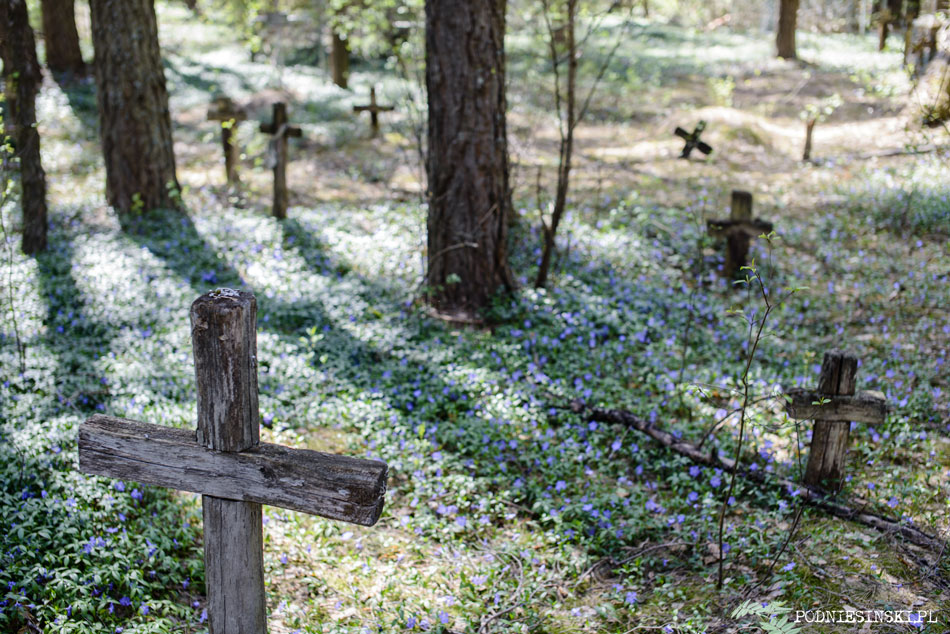
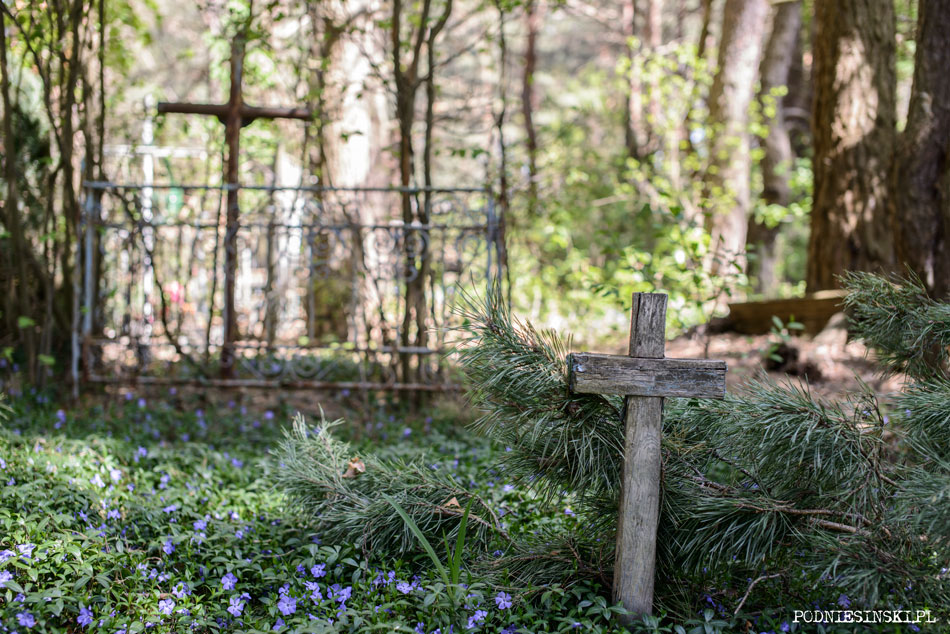

VICTORY DAY
My nearly two week stay in the zone doesn’t only include Easter. Several days later, the next holiday is celebrated ‒ Victory Day. On this particular day the Chernobyl zone is opened to all Ukrainians. This is how the Ukrainian authorities commemorate and celebrate the end of World War II. Thousands of Ukrainians take advantage of this occasion to visit the place where they once lived, or where their loved ones are buried. You can see whole families in cemeteries, remembering the dead and bringing and eating celebratory meals. And, of course, alcohol. Meeting at the graves of loved ones, in combination with a small feast and leaving some of the food on the grave, is an indispensable part of the Easter tradition of honouring the dead. In this joyful period, the souls of the dead also experience the joy of Resurrection.

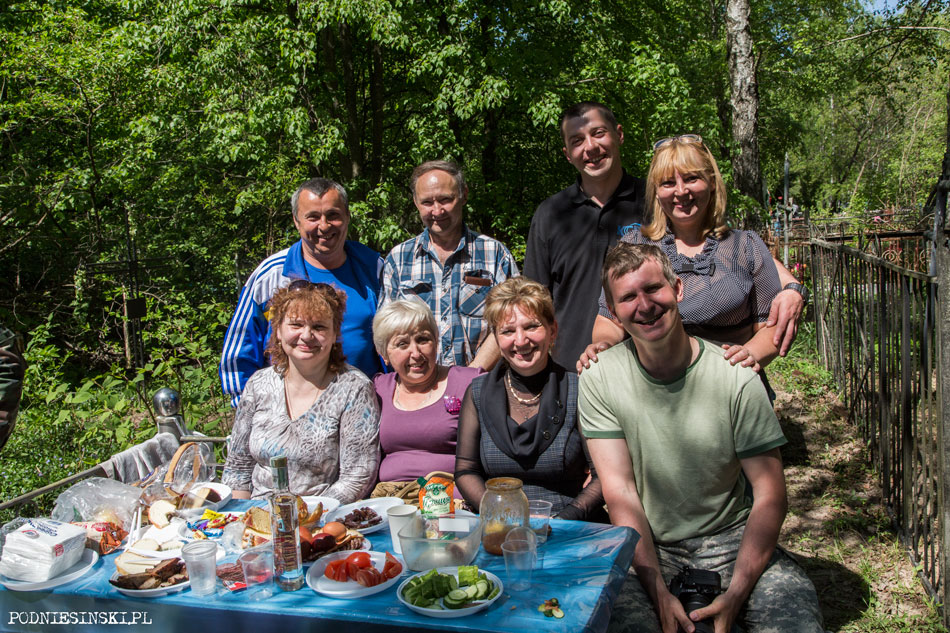
After a short conversation I’m already invited to the feast.

„spasiba diedu za pabiedu” – thank you for the victory, granddad. A grandson honours the memory of his granddad with this rhyming phrase. Unfortunately, granddad died a year ago, but granny still visits the village she used to live in every year.
Victory Day is the best time to meet former residents of the zone and get to know their histories, and the history of the places they used to live in. In the centre of Pripyat I meet a woman who is proud of her achievements ‒ she was responsible for establishing the first Komsomol (communist youth organisation) in Pripyat. A day later I’m stopped by a medic who, seeing my camera, tells me how he took the first injured firefighters to the hospital in Pripyat on the day of the disaster. He shows me his name and signature on the on-call list hanging on the wall of the hospital and in the reception book in the room next door. It’s really difficult for me to imagine how such a person would feel returning to a place where he used to work, lived, had a family, children. A place which his whole future was once intertwined with. His whole life.
I also visited resettlers, residents of the zone who were forced to move out who returned to their homes soon after the disaster. Despite their advanced age and very difficult conditions, they still live here. People I talked to include a married couple who are over 80 years old, living in the village of Nove Sheplichi, only a few hundred metres north of Pripyat. These two are the last living residents of zone I, located closest to the nuclear power plant. Unfortunately, the shortest road to the village, leading directly through Pripyat, was deliberately and continually closed soon after the disaster (embankment and ditch).
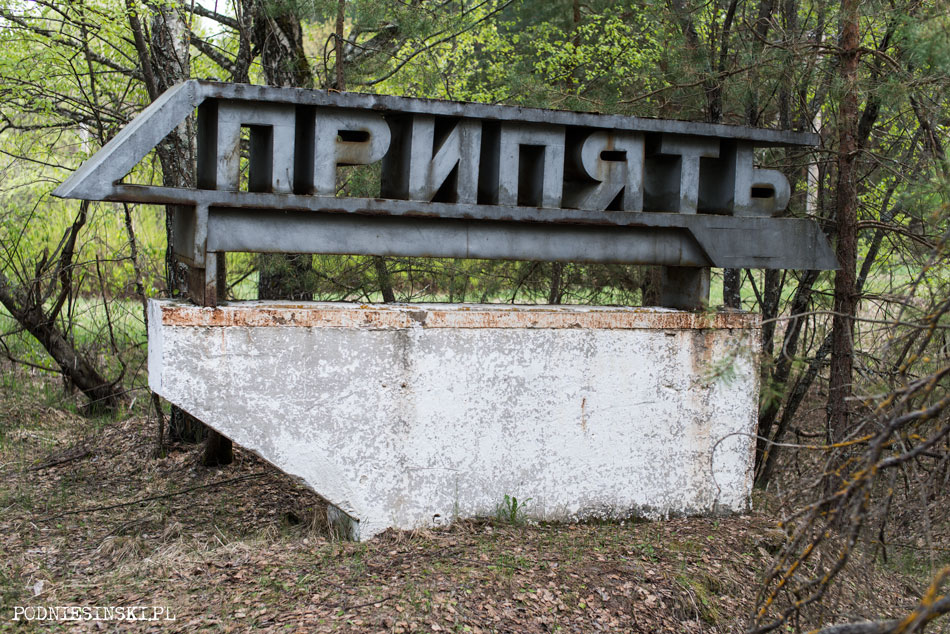
The second sign for Pripyat, on the northern road leading out of the town (currently impassable).
Access to the village is only possible from the west by making a detour of several kilometres of old overgrown roads. I tried to get there a month earlier, unfortunately given the heavy snowstorm that hit Ukraine it turned out to be impossible to find the road. And believe me, I tried. The large amount of snow, half metre drifts and, of course, no road services, no ploughs. 4 wheel drive, differential lock and reducers weren’t enough. The hoist I used more often in the zone than in half a year in Africa wasn’t enough. In such a large amount of snow, overgrown and unseen roads and the lack of any other tracks, it wasn’t possible to find appropriate transport.

April – centre of Pripyat.

April. Pripyat.Luckily there is an abundance of trees so it’s easy to pull myself out. After some time I’m already used to the fact that it only takes a few minutes to get out of even the biggest problems. But, as a reward, I can get almost anywhere.
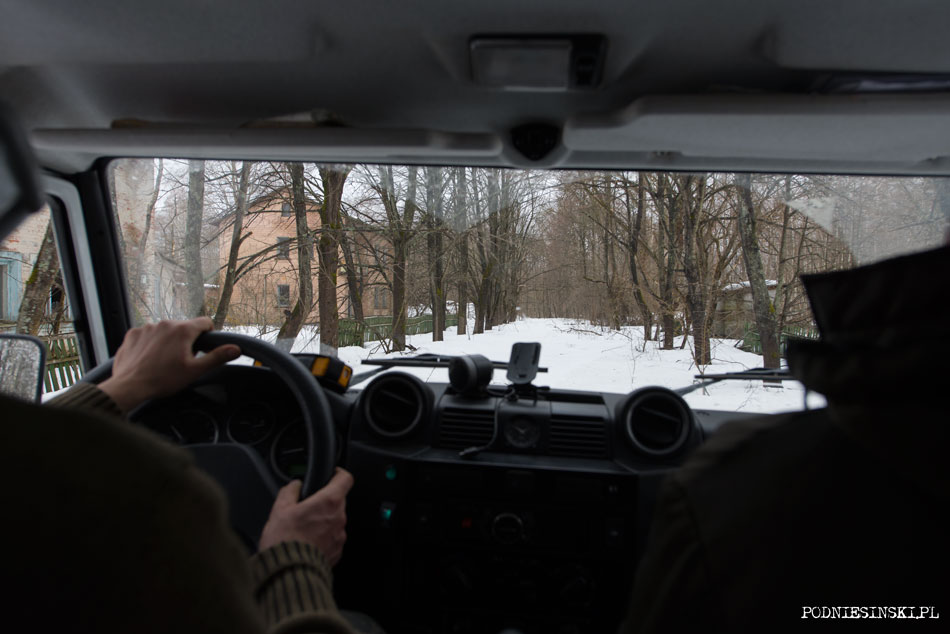
Looking for the old couple’s home.
I only make it in spring. After reaching the village it turns out that in winter we got stuck quite close to the house where the old couple lives. Despite their advanced age, the couple is in surprisingly good form, and appear to be happy. Surrounded by nature, from which they get not only peace and quiet, but also food. When asked, they unanimously confirm that they were never afraid to eat the products on offer in the nearby forests, full of mushrooms and berries and rivers full of fish. They agree that as long as they’re healthy that means there is no radiation. But mushrooms and fruit from the forest aren’t the most important source of their diet. The couple also keeps their own cows and chickens and until recently the old man would go to get some products by bicycle.

For anyone interested in the lives of former or current residents of the exclusion zone, I recommend the second part of the film Alone in the Zone. There will be interviews with all of the above mentioned people (and more).
Continued on next page



